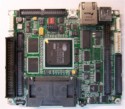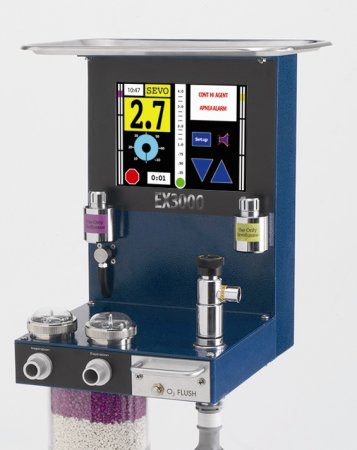Article: Linux helps bring state-of-the-art medical equipment to vets
Jan 9, 2007 — by LinuxDevices Staff — from the LinuxDevices Archive — 1 views Foreword: This article describes how Linux and a commercial off-the-shelf (COTS) single-board computer (SBC) helped Vetland Medical develop and market its EX3000 product, an inexpensive anesthesia monitoring device aimed at bringing technical innovations in human anesthesia… equipment to veterinarians.
Foreword: This article describes how Linux and a commercial off-the-shelf (COTS) single-board computer (SBC) helped Vetland Medical develop and market its EX3000 product, an inexpensive anesthesia monitoring device aimed at bringing technical innovations in human anesthesia… equipment to veterinarians.
Vetland Medical uses Linux to monitor anesthesia
by Lawrence Ricci
Surgery on pets is no less complex than surgery on humans, and the proper administration of anesthesia is critical for a safe and comfortable surgical experience for the animals. Whether used on human or animal patients, equipment to administer anesthesia must be sensitive and reliable, and able to detect and report hazardous conditions. Vetland Medical has created some of the first devices aimed at monitoring the administration of anesthesia to animals, using Linux to bring state-of-the-art capabilities and reliability to devices within the financial reach of veterinarians.
Background
Since the Civil War, the basics of anesthesiology have been constant. A liquid is vaporized and mixed with the air a patient breathes. The various anesthetics have improved over the years, as have the delivery mechanisms. But as the complexity of these systems increased, the problems associated with keeping them running properly also increase. This led to the emergence of sophisticated monitoring equipment aimed at detected any faults in anaesthesia delivery as quickly as possible.
Brad Rumph, President of Vetland Medical, came from a background of human medicine. Both he and Vetland founder Tom Hoehler had serviced and maintained human-certified anesthesia equipment. And, both had observed that as new monitoring devices were brought into human hospital operating theaters, the old equipment found its way into veterinary clinics.
Rumph realized that the same new anesthesia monitoring technologies could benefit animal patients just as well as people. The challenge was to deliver the same technology at a cost point attainable to veterinarians, and adapt it to meet special requirements of veterinary surgery, such as lower staffing levels.
The challenge
There are various types of anesthesia; some are used to put the patient to sleep quickly, while others properly maintain the unconscious state. Veterinarians like to use a quick-acting anesthesia to help the animal get immediately comfortable, and then shift to other anesthesias during the surgery. Anesthetics are transported and stored as liquids, but they are evaporated and mixed as a vapor with oxygen as they are administered. The ratio of anesthetic to oxygen must be kept within specific ranges. During the operation, precise control is required over the vaporization process, the blending with oxygen, and the changeover between various anesthetics. And, the situation must be constantly surveyed for alarm conditions, such as halt to the patient's breathing.
In the past, the vaporization and blending process was largely mechanical, and was controlled by the attendant anesthesiologist, who had to monitor not only what the equipment was doing, but what it might not be doing, due to an equipment failure such as a crimped hose or lack of oxygen. It was largely this monitoring and alarm function that encouraged the use of diligent, automated computer based systems for human anesthesiology — and which brought VetLand to apply the concept to veterinary equipment.
“Vets often have minimal surgical staff, and their assistants may not be as specialty-trained as the anesthesiologist or medical technician in a hospital operating room,” notes Rumph. “We saw that veterinarians need computer-based systems as much or even more than medical surgeons.”
Vetland decided to develop and commercialize a system essentially equivalent to human anesthesiology equipment, but to do it for less money and in less time than allotted for regulated equipment certified by the FDA (Federal Drug Administration). The system had to be small and compact, use the maximum automation and alarm monitoring possible to facilitate safe surgery with short-handed surgical teams, and generally be equally good and just as complete as the current state of the art would allow.
A bright display with large, easy-to-read numbers improves usability where operating staffs are limited in size
(Click to enlarge)
The solution
The initial design was done by an outside “turnkey” design firm, which created a fully functional system. However, the initial single-board computer (SBC) that had been selected proved to be unreliable. After some months, the problem was isolated, and determined to result from improper manufacturing techniques, which the supplier would not change.
Vets had started hearing about the product in design cycle, and demand was strong, but Vetland knew the device needed to be very reliable device before it could be deployed. So, the company looked for another board vendor.
Moving forward, the Vetland team was introduced to Gartech Enterprises, a design firm specializing in custom electronics. Gartech was hired, and set about finding a Linux-compatible board to migrate the product to. Fortunately, Linux's vendor-neutrality and low- to no-cost nature meant that Gartech had a wide variety of Linux-compatible hardware from which to choose.
Mike Hill explains, “We wanted to keep working on Linux, as that's what was used before, and the schedule would be tight. We researched on the Internet and found several firms with ARM-based SBCs that support Linux.”
 ADS “Sphere” SBC (Click to enlarge) |
Ultimately, Gartech settled on the Sphere SBC from Applied Data Systems (ADS), a Maryland-based embedded systems house specializing in low-power, graphics-oriented SBC designs. The board is based on a 200MHz Cirrus EP9315 CPU, and enjoys complete support under Linux. Hill explained, “The Sphere system runs full Debian Linux out of the box. It has all the I/O we needed, and all the I/O was fully software supported.”
According to Hill, Gartech was able to quickly get the necessary software ported to the Sphere SBC, after ADS support staff helped integrate the needed graphics framework. “We were able to get the control and monitoring software up and running ahead of schedule,” he recalls.
Results
The system was put into operation (no pun intended) quickly, and now successfully monitors the anesthesia equipment for failures that could endanger the pet. If anything ever goes wrong with the flow rate, there is an immediate change on the touchscreen with an audible alarm. This system is an excellent additional safeguard for the vet and for the team working with the animal.
The electronics were designed so that vets can choose multiple drugs while monitoring oxygen supply, breathing, and lung pressures. The unit also performs continual safety tests in the background that verify proper drug delivery. Further, there is great flexibility, as the system can work with different sized animals.
“We know how important pets are to their owners. Linux and the ADS Sphere are reliable, and that is important. The vets have to trust this equipment,” Rumph adds.
According to Vetland, the system has been through trials in the U.S. and Canada, and initial sales have been brisk. Its low-cost, easy-to-use graphic interface and reliability have made it a favorite for veterinary surgery. It seems the trend toward computer-based anesthesiology, evident in human medicine over the last few years, will repeat for animal care as well.
 About the author — Lawrence Ricci is Business Development Manager at Applied Data Systems in Columbia, Maryland. Ricci is active in the embedded community and publishes extensively. His particular interests include development of smart, communicating devices based on open standard Web services technologies. He can be reached via email.
About the author — Lawrence Ricci is Business Development Manager at Applied Data Systems in Columbia, Maryland. Ricci is active in the embedded community and publishes extensively. His particular interests include development of smart, communicating devices based on open standard Web services technologies. He can be reached via email.
This article was originally published on LinuxDevices.com and has been donated to the open source community by QuinStreet Inc. Please visit LinuxToday.com for up-to-date news and articles about Linux and open source.
